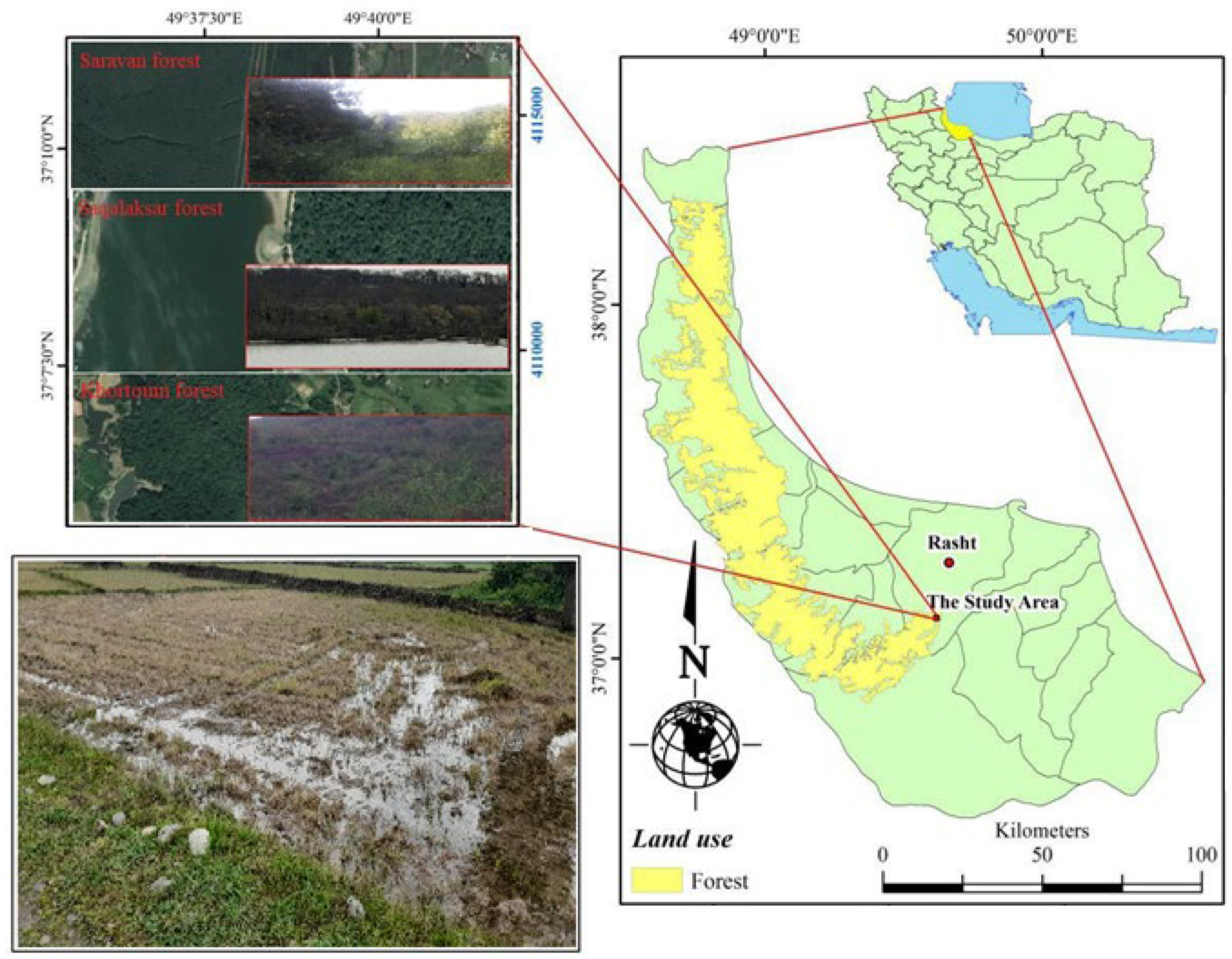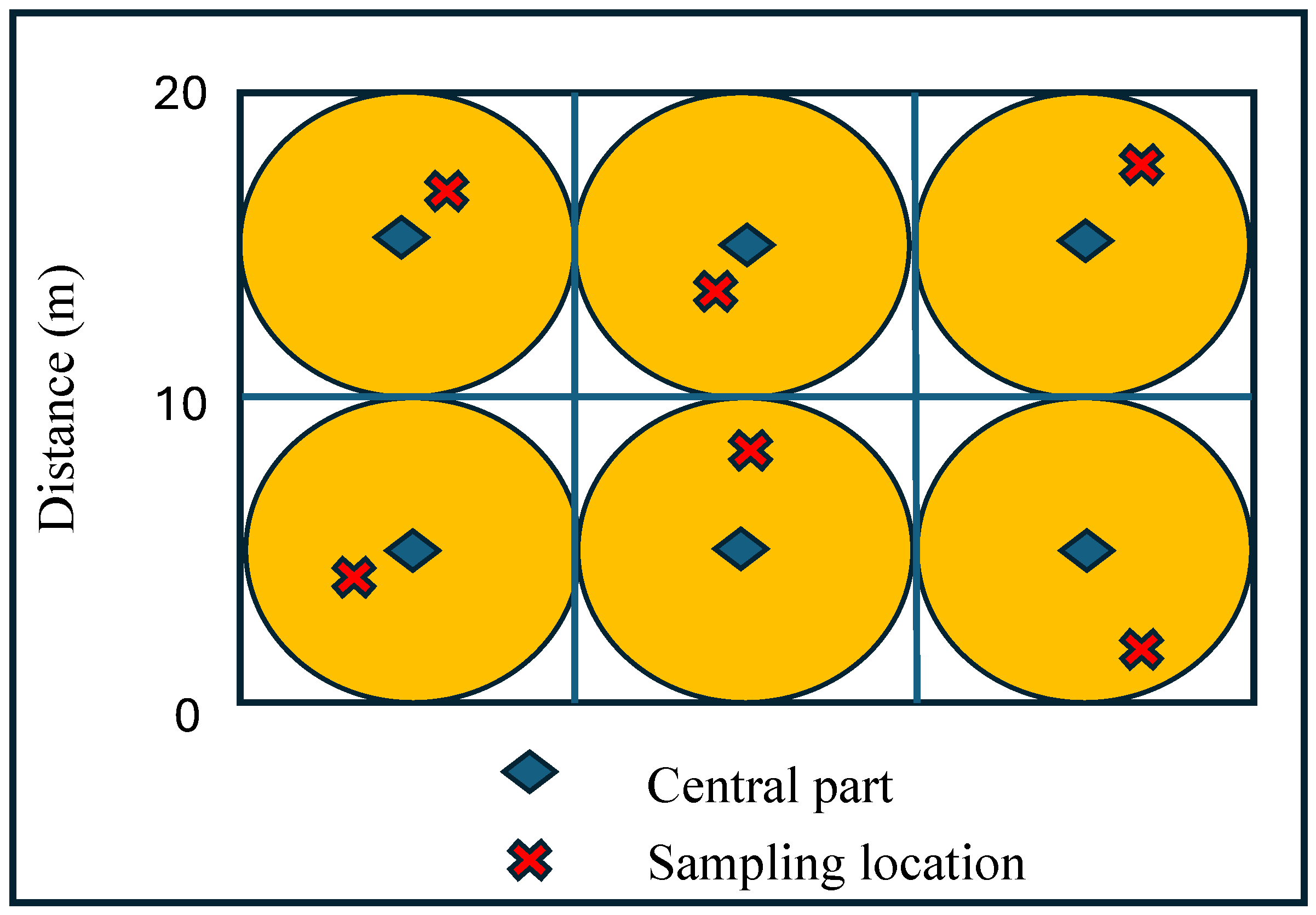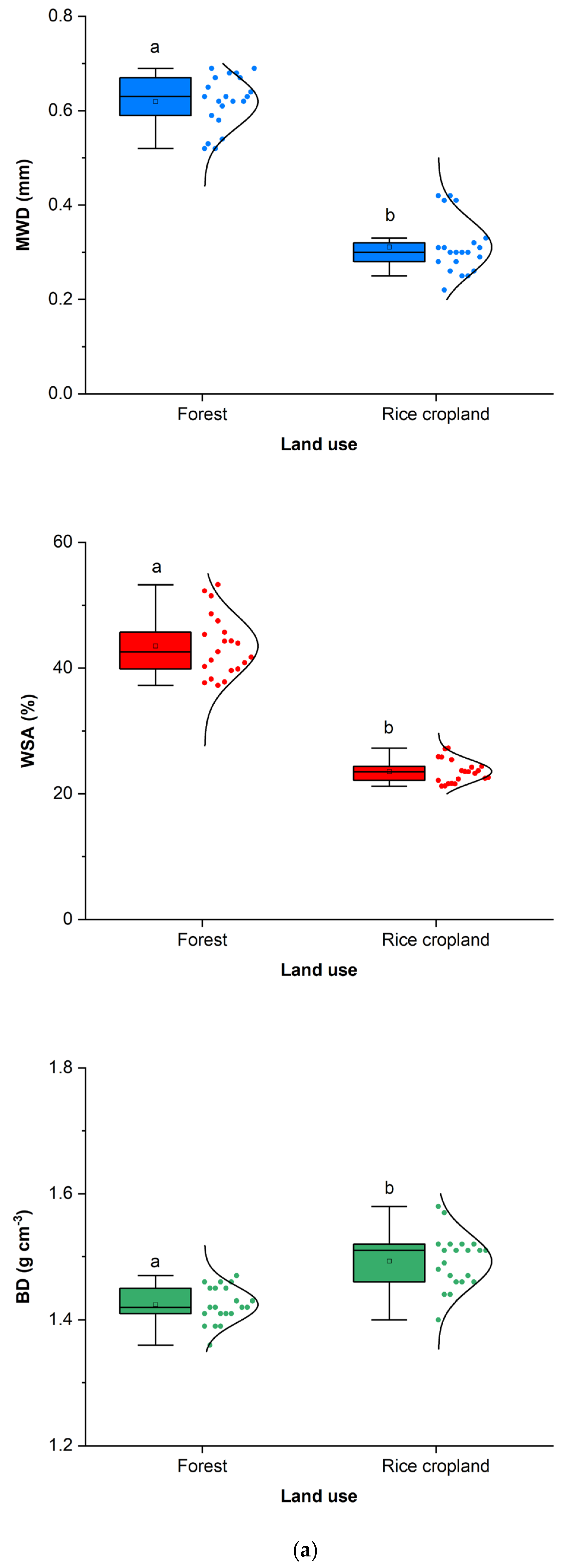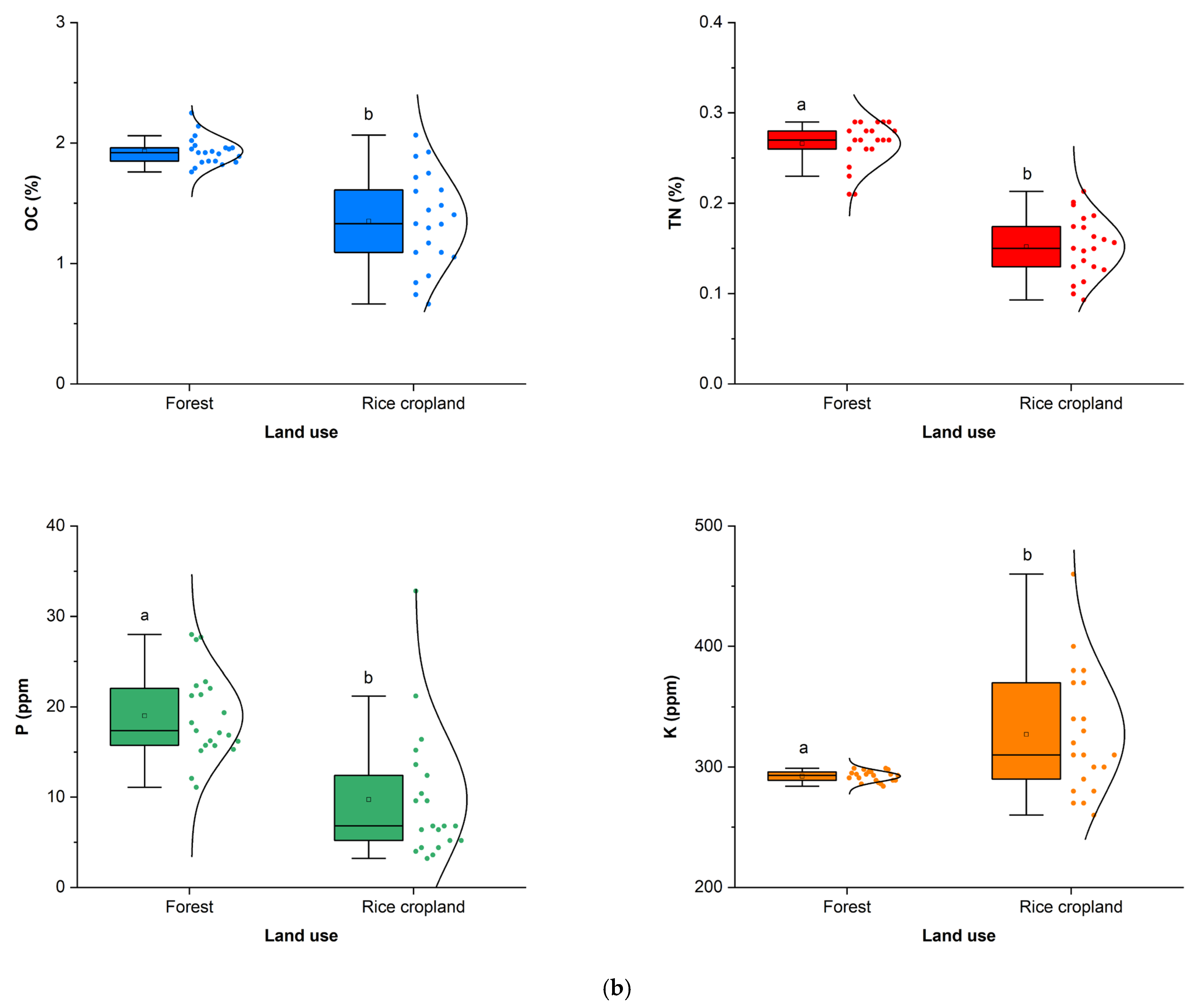Assessing Soil Quality in Conversion of Burned Forestlands to Rice Croplands: A Case Study in Northern Iran
Abstract
1. Introduction
2. Materials and Methods
2.1. Study Areas
2.2. Soil Sampling and Analyses
2.3. Evaluation of Soil Quality Index
2.4. Statistical Analysis
3. Results
3.1. Variations in Soil Properties Between Forestland and Rice Cropland
3.2. Discrimination in Soil Properties Between the Two Land Uses
3.3. Difference in the Soil Quality Index Between the Two Land Uses
4. Discussion
5. Conclusions
Author Contributions
Funding
Informed Consent Statement
Data Availability Statement
Conflicts of Interest
Appendix A
| MWD | WSA | BD | pH | EC | OC | TN | P | K | Mn | Zn | CEC | |
|---|---|---|---|---|---|---|---|---|---|---|---|---|
| MWD | 1 | 0.85 | −0.63 | −0.02 | −0.86 | 0.58 | 0.80 | 0.47 | −0.53 | −0.10 | 0.03 | 0.74 |
| WSA | 0.85 | 1 | −0.66 | −0.09 | −0.90 | 0.65 | 0.84 | 0.67 | −0.44 | −0.19 | −0.08 | 0.81 |
| BD | −0.63 | −0.66 | 1 | −0.05 | 0.64 | −0.51 | −0.62 | −0.31 | 0.22 | 0.25 | −0.11 | −0.61 |
| pH | −0.02 | −0.09 | −0.05 | 1 | −0.14 | −0.61 | −0.37 | −0.46 | −0.38 | −0.16 | 0.27 | −0.04 |
| EC | −0.86 | −0.90 | 0.64 | −0.14 | 1 | −0.42 | −0.67 | −0.43 | 0.59 | 0.24 | 0.09 | −0.76 |
| OC | 0.58 | 0.65 | −0.51 | −0.61 | −0.42 | 1 | 0.90 | 0.75 | 0.01 | −0.12 | −0.06 | 0.63 |
| TN | 0.80 | 0.84 | −0.62 | −0.37 | −0.67 | 0.90 | 1 | 0.72 | −0.22 | −0.23 | −0.07 | 0.79 |
| P | 0.47 | 0.67 | −0.31 | −0.46 | −0.43 | 0.75 | 0.72 | 1 | 0.05 | 0.07 | −0.13 | 0.52 |
| K | −0.53 | −0.44 | 0.22 | −0.38 | 0.59 | 0.01 | −0.22 | 0.05 | 1 | −0.02 | −0.17 | −0.25 |
| Mn | −0.10 | −0.19 | 0.25 | −0.16 | 0.24 | −0.12 | −0.23 | 0.07 | −0.02 | 1 | 0.03 | −0.44 |
| Zn | 0.03 | −0.08 | −0.11 | 0.27 | 0.09 | −0.06 | −0.07 | −0.13 | −0.17 | 0.03 | 1 | 0.00 |
| CEC | 0.74 | 0.81 | −0.61 | −0.04 | −0.76 | 0.63 | 0.79 | 0.52 | −0.25 | −0.44 | 0.00 | 1 |
References
- Yan, X.; Liu, M.; Zhong, J.; Guo, J.; Wu, W. How Human Activities Affect Heavy Metal Contamination of Soil and Sediment in a Long-Term Reclaimed Area of the Liaohe River Delta, North China. Sustainability 2018, 10, 338. [Google Scholar] [CrossRef]
- Sun, W.; Li, S.; Zhang, G.; Fu, G.; Qi, H.; Li, T. Effects of climate change and anthropogenic activities on soil pH in grassland regions on the Tibetan Plateau. Glob. Ecol. Conserv. 2023, 45, e02532. [Google Scholar] [CrossRef]
- Salgado, L.; Alvarez, M.G.; Díaz, A.M.; Gallego, J.R.; Forján, R. Impact of wildfire recurrence on soil properties and organic carbon fractions. J. Environ. Manag. 2024, 354, 120293. [Google Scholar] [CrossRef] [PubMed]
- Parhizkar, M.; Lucas-Borja, M.E.; Zema, D.A. Rill Erosion Due to Wildfire or Deforestation in Forestlands of Northern Iran. Forests 2024, 15, 1926. [Google Scholar] [CrossRef]
- Sutanto, S.J.; Vitolo, C.; Napoli, C.D.; D’Andrea, M.; Van Lanen, H.A.J. Heatwaves, droughts, and fires: Exploring compound and cascading dry hazards at the pan-European scale. Environ. Int. 2020, 134, 105276. [Google Scholar] [CrossRef] [PubMed]
- Parhizkar, M.; Cerdà, A. Modelling effects of human-caused fires on rill detachment capacity based on surface burning of soils in forest lands. J. Hydrol. 2023, 624, 129893. [Google Scholar] [CrossRef]
- Zafar, S.; Jianlong, X. Recent Advances to Enhance Nutritional Quality of Rice. Rice Sci. 2023, 30, 523–536. [Google Scholar] [CrossRef]
- Zhang, H.; Li, X.; Zhou, J.; Wang, J.; Wang, L.; Yuan, J.; Xu, C.; Dong, Y.; Chen, Y.; Ai, Y.; et al. Combined Application of Chemical Fertilizer and Organic Amendment Improved Soil Quality in a Wheat–Sweet Potato Rotation System. Agronomy 2024, 14, 2160. [Google Scholar] [CrossRef]
- Pielke, R.A., Sr.; Pitman, A.; Niyogi, D.; Mahmood, R.; McAlpine, C.; Hossain, F.; Goldewijk, K.K.; Nair, U.; Betts, R.; Fall, S.; et al. Land use/land cover changes and climate: Modeling analysis and observational evidence. Wiley Interdiscip. Rev. Clim. Change 2011, 2, 828–850. [Google Scholar] [CrossRef]
- Gaitanis, A.; Kalogeropoulos, K.; Detsis, V.; Chalkias, C. Monitoring 60 years of land cover change in the Marathon Area, Greece. Land 2015, 4, 337–354. [Google Scholar] [CrossRef]
- Strandberg, G.; Kjellström, E. Climate impacts from afforestation and deforestation in Europe. Earth Interact. 2019, 23, 1–27. [Google Scholar] [CrossRef]
- Parcerisas, L.; Marull, J.; Pino, J.; Tello, E.; Coll, F.; Basnou, C. Land use changes, landscape ecology and their socioeconomic driving forces in the Spanish Mediterranean coast (El Maresme County, 1850–2005). Environ. Sci. Policy 2012, 23, 120–132. [Google Scholar] [CrossRef]
- Meneses, B.; Reis, E.; Pereira, S.; Vale, M.; Reis, R. Understanding driving forces and implications associated with the land use and land cover changes in Portugal. Sustainability 2017, 9, 351. [Google Scholar] [CrossRef]
- Krajewski, P.; Solecka, I.; Mrozik, K. Forest landscape change and preliminary study on its driving forces in Ślęża Landscape Park (Southwestern Poland) in 1883–2013. Sustainability 2018, 10, 4526. [Google Scholar] [CrossRef]
- Parhizkar, M.; Lucas-Borja, M.E.; Zema, D.A. Changes in rill detachment capacity after deforestation and soil conservation practices in forestlands of Northern Iran. Catena 2024, 246, 108405. [Google Scholar] [CrossRef]
- Louwagie, G.; Gay, S.H.; Sammeth, F.; Ratinger, T. The potential of European Union policies to address soil degradation in agriculture. Land Degrad. Dev. 2011, 25, 5–17. [Google Scholar] [CrossRef]
- Gzyl, J. Soil protection in central and eastern Europe. J. Geochem. Explor. 1999, 66, 333–337. [Google Scholar] [CrossRef]
- Chauhan, R.; Datta, A.; Ramanathan, A.L.; Adhya, T.K. Whether conversion of mangrove forest to rice cropland is environmentally and economically viable? Agric. Ecosyst. Environ. 2017, 246, 38–47. [Google Scholar] [CrossRef]
- Kottek, M.; Grieser, J.; Beck, C.; Rudolf, B.; Rubel, F. World Map of the Köppen-Geiger climate classification updated. Meteorol. Z. 2006, 15, 259–263. [Google Scholar] [CrossRef]
- Ghasemzadeh, Z.; Parhizkar, M.; Zomorodian, M.; Shamsi, S.; Shabanpour, M. The role of extracellular polysaccharide produced by Bradyrhizobium strain in root growth, improvement of soil aggregate stability and reduction of soil detachment capacity. Rhizosphere 2023, 27, 100771. [Google Scholar] [CrossRef]
- Gholoubi, A.; Emami, H.; Alizadeh, A.; Azadi, R. Long term effects of deforestation on soil attributes: Case study, Northern Iran. Casp. J. Environ. Sci. 2019, 17, 73–81. [Google Scholar]
- Gee, G.W.; Bauder, J.W. Particle-size analysis. In Methods of Soil Analysis, Part 1. Physical and Minerological Methods; Klute, A., Ed.; ASA-SSSA: Madison, WI, USA, 1986; pp. 383–411. [Google Scholar]
- Walkley, A.; Black, I.A. An examination of the Degtjareff method for determining soil organic matter and a proposed modification of the chromic acid titration method. Soil Sci. 1934, 37, 29–38. [Google Scholar] [CrossRef]
- Hesse, P.R. A Text Book of Soil Chemical Analysis; John Nurray Williams Clowes and Sons Ltd.: London, UK, 1971; p. 324. [Google Scholar]
- Radcliffe, D.E.; Simunek, J. Soil Physics with HYDRUS: Modeling and Applications; CRC Press: Boca Raton, FL, USA, 2018. [Google Scholar]
- Kemper, W.D.; Rosenau, R.C. Aggregate stability and size distribution. In Methods of Soil Analysis: Part 1 Physical and Mineralogical Methods; American Society of Agronomy: Madison, WI, USA, 1986. [Google Scholar]
- Bremner, J.M. Total nitrogen. In Methods of Soil Analysis, Part 2 Chemical and Microbiological Properties; American Society of Agronomy: Madison, WI, USA, 1982; Volume 10, pp. 594–624. [Google Scholar]
- Claessen, M.E.C. Manual for Methods of Soil Analysis; Embrapa Solos: Rio de Janeiro, Brazil, 1997. [Google Scholar]
- Chapman, H.D. Cation exchange capacity. In Methods of Soil Analysis; Black, C.A., Ed.; American Society of Agronomy: Madison, WI, USA, 1965; pp. 891–901. [Google Scholar]
- Andrews, S.S.; Karlen, D.L.; Mitchell, J.P. A comparison of soil quality indexing methods for vegetable production systems in Northern California. Agric. Ecosyst. Environ. 2002, 90, 25–45. [Google Scholar] [CrossRef]
- Wander, M.M.; Bollero, G.A. Soil Quality Assessment of Tillage Impacts in Illinois. Soil Sci. Soc. Am. J. 1999, 63, 961–971. [Google Scholar] [CrossRef]
- Lee Rodgers, J.; Nicewander, W.A. Thirteen ways to look at the correlation coefficient. Am. Stat. 1988, 42, 59–66. [Google Scholar] [CrossRef]
- Wu, J.; Teng, B.; Zhong, Y.; Duan, X.; Gong, L.; Guo, W.; Qi, P.; Haider, F.U.; Cai, L. Enhancing Soil Aggregate Stability and Organic Carbon in Northwestern China through Straw, Biochar, and Nitrogen Supplementation. Agronomy 2024, 14, 899. [Google Scholar] [CrossRef]
- Pan, Z.; Cai, X.; Bo, Y.; Guan, C.; Cai, L.; Haider, F.U.; Li, X.; Yu, H. Response of soil organic carbon and soil aggregate stability to changes in land use patterns on the Loess Plateau. Sci. Rep. 2024, 14, 31775. [Google Scholar] [CrossRef] [PubMed]
- Sarker, T.C.; Incerti, G.; Spaccini, R.; Piccolo, A.; Mazzoleni, S.; Bonanomi, G. Linking organic matter chemistry with soil aggregate stability: Insight from 13C NMR spectroscopy. Soil Biol. Biochem. 2018, 117, 175–184. [Google Scholar] [CrossRef]
- Zhu, G.Y.; Shangguan, Z.P.; Deng, L. Variations in soil aggregate stability due to land use changes from agricultural land on the Loess Plateau, China. Catena 2021, 200, 105181. [Google Scholar] [CrossRef]
- Lan, J. Changes of soil aggregate stability and erodibility after cropland conversion in degraded karst region. J. Soil Sci. Plant Nutr. 2021, 21, 3333–3345. [Google Scholar] [CrossRef]
- Hasanah, U.; Amami, A.A.; Amelia, R. Forest conversion to agricultural lands: Impact on soil physical characteristics. IOP Conf. Ser. Earth Environ. Sci. 2023, 1253, 012027. [Google Scholar] [CrossRef]
- Yang, X.; Wang, B.; Fakher, A.; An, S.; Kuzyakov, Y. Contribution of roots to soil organic carbon: From growth to decomposition experiment. Catena 2023, 231, 107317. [Google Scholar] [CrossRef]
- Mishra, S.; Page, S.E.; Cobb, A.R.; Lee, J.S.H.; Jovani-Sancho, A.J.; Sjögersten, S.; Jaya, A.; Aswandi; Wardle, D.A. Degradation of Southeast Asian tropical peatlands and integrated strategies for their better management and restoration. J. Appl. Ecol. 2021, 58, 1370–1387. [Google Scholar] [CrossRef]
- Beheshti, A.; Raiesi, F.; Golchin, A. Soil properties, C fractions and their dynamics in land use conversion from native forests to croplands in northern Iran. Agric. Ecosyst. Environ. 2012, 148, 121–133. [Google Scholar] [CrossRef]
- Reyna-Bowen, L.; Fernandez-Rebollo, P.; Fernández-Habas, J.; Gómez, J.A. The influence of tree and soil management on soil organic carbon stock and pools in dehesa systems. Catena 2020, 190, 104511. [Google Scholar] [CrossRef]
- Cao, R.; Chen, L.; Hou, X.; Lü, X.; Li, H. Nitrogen addition reduced carbon mineralization of aggregates in forest soils but enhanced in paddy soils in South China. Ecol. Process 2021, 10, 45. [Google Scholar] [CrossRef]
- Wei, X.; Shao, M.; Gale, W.; Li, L. Global pattern of soil carbon losses due to the conversion of forests to agricultural land. Sci. Rep. 2014, 4, 4062. [Google Scholar] [CrossRef]
- Cai, Y.; Xiao, J.; Liao, X.; Dong, Y.; Pan, B.; Zhang, L.; Xie, G.; Chen, Y.; Xie, Y. Dryland-to-Paddy Conversions Lead to Short-Term Decreases in Soil Organic Carbon and Carbon Pool Management Index in Karst Soil of Guizhou Province, China. Agriculture 2025, 15, 396. [Google Scholar] [CrossRef]
- Wang, C.; Zhao, Y.; Hao, S.; Chen, J.; Chen, S.; Liu, J.; Liu, H.; Zhu, X.; Li, X.; Zhang, A. Effects of composted straw, biochar, and polyacrylamide addition on soil permeability and dynamic leaching characteristics of pollutants in loessial soil in urban greenbelts according to indoor simulation experiments. Agronomy 2024, 14, 1958. [Google Scholar] [CrossRef]
- Valenzuela-Balcázar, I.G.; Visconti-Moreno, E.F.; Faz, Á.; Acosta, J.A. Soil Organic Carbon Dynamics in Two Rice Cultivation Systems Compared to an Agroforestry Cultivation System. Agronomy 2022, 12, 17. [Google Scholar] [CrossRef]
- Jiang, X.; Amelung, W.; Cade-Menun, B.J.; Bol, R.; Willbold, S.; Cao, Z.; Klumpp, E. Soil organic phosphorus transformations during 2000 years of paddy-rice and non-paddy management in the Yangtze River Delta, China. Sci. Rep. 2017, 7, 10818. [Google Scholar] [CrossRef]
- Atapattu, A.J.; Rohitha Prasantha, B.D.; Amaratunga, K.S.P.; Marambe, B. Increased rate of potassium fertilizer at the time of heading enhances the quality of direct seeded rice. Chem. Biol. Technol. Agric. 2018, 5, 22. [Google Scholar] [CrossRef]
- Yang, T.; Samarakoon, U.; Altland, J.; Ling, P. Influence of Electrical Conductivity on Plant Growth, Nutritional Quality, and Phytochemical Properties of Kale (Brassica napus) and Collard (Brassica oleracea) Grown Using Hydroponics. Agronomy 2024, 14, 2704. [Google Scholar] [CrossRef]
- Islam, M.N.; Islam, A.; Biswas, J.C. Effect of gypsum on electrical conductivity and sodium concentration in salt affected paddy soil. Int. J. Agric. Pap. 2017, 2, 19–23. [Google Scholar]
- Li, H.Y.; Shi, Z.; Webster, R.; Triantafilis, J. Mapping the three-dimensional variation of soil salinity in a rice-paddy soil. Geoderma 2013, 195, 31–41. [Google Scholar] [CrossRef]
- Xiao, Q.; He, B.; Wang, S. Effect of the Different Fertilization Treatments Application on Paddy Soil Enzyme Activities and Bacterial Community Composition. Agronomy 2023, 13, 712. [Google Scholar] [CrossRef]
- Sharma, A.; Weindorf, D.C.; Wang, D.; Chakraborty, S. Characterizing soils via portable X-ray fluorescence spectrometer: 4. Cation exchange capacity (CEC). Geoderma 2015, 239, 130–134. [Google Scholar] [CrossRef]
- Bi, X.; Chu, H.; Fu, M.; Xu, D.; Zhao, W.; Zhong, Y.; Wang, M.; Li, K.; Zhang, Y.-N. Distribution characteristics of organic carbon (nitrogen) content, cation exchange capacity, and specific surface area in different soil particle sizes. Sci. Rep. 2023, 13, 12242. [Google Scholar] [CrossRef]
- Msofe, N.K.; Sheng, L.; Li, Z.; Wang, L.; Msofe, N.K.; Msofe, N.K.; Sheng, L.; Li, Z.; Wang, L. Influence of agricultural land use change on the selected physico-chemical soil properties in kilombero valley floodplain, Southeastern Tanzania. Int. J. Environ. Sci. Nat. Resour. 2019, 21, 1–11. [Google Scholar] [CrossRef]
- Huang, L.; Liu, X.; Wang, Z.; Liang, Z.; Wang, M.; Liu, M.; Suarez, D.L. Interactive effects of pH, EC and nitrogen on yields and nutrient absorption of rice (Oryza sativa L.). Agric. Water Manag. 2017, 194, 48–57. [Google Scholar] [CrossRef]
- Liu, T.; Wu, X.; Li, H.; Alharbi, H.; Wang, J.; Dang, P.; Chen, X.; Kuzyakov, Y.; Yan, W. Soil organic matter, nitrogen and pH driven change in bacterial community following forest conversion. For. Ecol. Manag. 2020, 477, 118473. [Google Scholar] [CrossRef]
- Islam, K.R.; Weil, R.R. Land use effects on soil quality in a tropical forest ecosystem of Bangladesh. Agric. Ecosyst. Environ. 2000, 79, 9–16. [Google Scholar] [CrossRef]
- Ouyang, Z.; Jackson, R.B.; McNicol, G.; Fluet-Chouinard, E.; Runkle, B.R.; Papale, D.; Knox, S.H.; Cooley, S.; Delwiche, K.B.; Feron, S.; et al. Paddy rice methane emissions across Monsoon Asia. Remote Sens. Environ. 2023, 284, 113335. [Google Scholar] [CrossRef]
- Mallareddy, M.; Thirumalaikumar, R.; Balasubramanian, P.; Naseeruddin, R.; Nithya, N.; Mariadoss, A.; Eazhilkrishna, N.; Choudhary, A.K.; Deiveegan, M.; Subramanian, E.; et al. Maximizing Water Use Efficiency in Rice Farming: A Comprehensive Review of Innovative Irrigation Management Technologies. Water 2023, 15, 1802. [Google Scholar] [CrossRef]
- Parhizkar, M.; Shabanpour, M.; Lucas-Borja, M.E.; Zema, D.A.; Li, S.; Tanaka, N.; Cerdà, A. Effects of length and application rate of rice straw mulch on surface runoff and soil loss under laboratory simulated rainfall. Int. J. Sediment Res. 2021, 36, 468–478. [Google Scholar] [CrossRef]
- Faoziyah, U.; Rosyaridho, M.F.; Panggabean, R. Unearthing agricultural land use dynamics in Indonesia: Between food security and policy interventions. Land 2024, 13, 2030. [Google Scholar] [CrossRef]
- Ghasemzadeh, Z.; Parhizkar, M.; Mirmohammadmeygooni, S.; Shabanpour, M.; Chalmers, G. Forest soil inoculation with Bacillus subtilus reduces soil detachment rate to mitigate rill erosion. Rhizosphere 2023, 26, 100707. [Google Scholar] [CrossRef]
- Kumar, U.; Kaviraj, M.; Panneerselvam, P.; Nayak, A.K. Conversion of mangroves into rice cultivation alters functional soil microbial community in sub-humid tropical paddy soil. Front. Environ. Sci. 2022, 10, 858028. [Google Scholar] [CrossRef]
- Raiesi, F.; Beheshti, A. Soil specific enzyme activity shows more clearly soil responses to paddy rice cultivation than absolute enzyme activity in primary forests of northwest Iran. Appl. Soil Ecol. 2014, 75, 63–70. [Google Scholar] [CrossRef]








| Characteristics | Forests | Rice Croplands | |
|---|---|---|---|
| Morphology | Altitude (m a.s.l.) | 50 to 250 | 30 to 150 |
| Slope (%) | 1 to 3 | ||
| Climate | Mean precipitation (mm/yr) | 1360 | |
| Mean temperature (°C) | 16.3 | ||
| Soil | Texture | Silty clay loamy | Silty clay |
| Sand content (%) | 13 | 10 | |
| Silt content (%) | 50 | 48 | |
| Clay content (%) | 37 | 42 | |
Disclaimer/Publisher’s Note: The statements, opinions and data contained in all publications are solely those of the individual author(s) and contributor(s) and not of MDPI and/or the editor(s). MDPI and/or the editor(s) disclaim responsibility for any injury to people or property resulting from any ideas, methods, instructions or products referred to in the content. |
© 2025 by the authors. Licensee MDPI, Basel, Switzerland. This article is an open access article distributed under the terms and conditions of the Creative Commons Attribution (CC BY) license (https://creativecommons.org/licenses/by/4.0/).
Share and Cite
Parhizkar, M.; Jafari, S.B.; Ghasemzadeh, Z.; Denisi, P.; Zema, D.A. Assessing Soil Quality in Conversion of Burned Forestlands to Rice Croplands: A Case Study in Northern Iran. Resources 2025, 14, 141. https://doi.org/10.3390/resources14090141
Parhizkar M, Jafari SB, Ghasemzadeh Z, Denisi P, Zema DA. Assessing Soil Quality in Conversion of Burned Forestlands to Rice Croplands: A Case Study in Northern Iran. Resources. 2025; 14(9):141. https://doi.org/10.3390/resources14090141
Chicago/Turabian StyleParhizkar, Misagh, Shahryar Babazadeh Jafari, Zeinab Ghasemzadeh, Pietro Denisi, and Demetrio Antonio Zema. 2025. "Assessing Soil Quality in Conversion of Burned Forestlands to Rice Croplands: A Case Study in Northern Iran" Resources 14, no. 9: 141. https://doi.org/10.3390/resources14090141
APA StyleParhizkar, M., Jafari, S. B., Ghasemzadeh, Z., Denisi, P., & Zema, D. A. (2025). Assessing Soil Quality in Conversion of Burned Forestlands to Rice Croplands: A Case Study in Northern Iran. Resources, 14(9), 141. https://doi.org/10.3390/resources14090141









